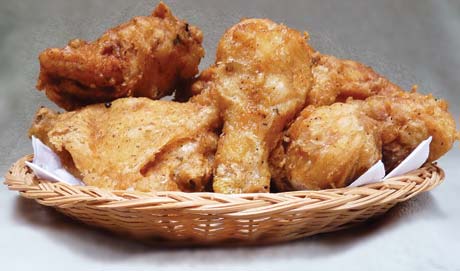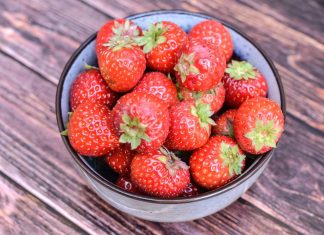 |
|
| Issue #126 • November/December, 2010 |
Over the past 30 years I’ve devoted many hours to researching, developing, and testing recipes that provide my family and me with healthy and good tasting meals. My background in planning, preparing, and serving similar meals to hospital, nursing home, and retirement home patients has made this effort relatively easy and enjoyable.
Like folks everywhere, I fight a daily battle to maintain my weight at a manageable level. Exercising, eating plenty of fruits and vegetables, and avoiding highly-manufactured sugary foods helps me do this successfullymost of the time.
However, I must admit there are days when I need a break from the sometimes brain-numbing management of cholesterol and fiber, carbohydrate, and fat consumption. As beneficial and vital as this approach to diet is, there is a problem that surfaces from time to time for anyone who carefully watches what he eats. For me, this problem manifests itself whenever I visit any of my favorite fishing spots on Cape Cod.
The Cape is home to many of the finest seafood restaurants in the world. Most of them feature a wide selection of fried fish and shellfish, usually served with homemade thick-cut fries that are crispy on the outside with soft and grease-free interiors. The meals in these restaurants are often prepared by local cooks who own and manage the business as well as run the busy kitchen.
On every visit to this area I am overcome by a tremendous urge to eat fried seafood. I get this same urge when I visit other parts of the country where I have been fortunate enough to eat fried chicken with a crisp flavorful coating and moist interior, and pan-fried steak served with cream gravy, homemade mashed potatoes, and a fresh vegetable, in-season, delivered daily by a local farmer.
But as a professional cook I know that a steady diet of fried foods is more than any human body should be subjected to if it’s to remain in good health.
|
We are all constantly bombarded with an “eat this but don’t eat that” approach to our daily food choices. The “eat this” method of diet selection can be carried too far, leading us to select our food based solely on nutrient content, often passing up or purchasing a food based on the presence or absence of a single nutrient.
But I’m here to tell you this: Eating a food with saturated fat, sugar, or salt is not going to kill you on the spot. Likewise, eating a particular fruit, vegetable, or whole grain is not going to provide you with lifetime protection against heart disease, cancer, or diabetes.
Humans, by design, are omnivores; that is, we can eat most of what Mother Nature has to offer. In fact, we need to eat a wide variety of things if we want to stay healthy.
Unfortunately, we live in a society that obsesses over the consequences of our food choices. In spite of all this worry, we somehow manage to suffer from a long list of diet-related illnesses. The reasons for this are still being sorted out by the experts. Several books, written by credible authors, cover this unfortunate consequence of our overall eating habits. After spending many hours sitting in bus stations, shopping mall food courts, and fast food restaurants observing folks eat, I am convinced that it is not what we eat but how much we eat that causes many food-related problems.
Some years back, when I finally decided I had to lose at least 35 pounds, lower my cholesterol, and get my body back in shape. I got help from a longtime friend, a registered dietitian employed at a large hospital in Boston. She constructed a weight-loss plan that both made me groan and sigh in relief. The portion sizes were a third of what I was accustomed to eating. On the other hand, along with a substantial increase in the frequency and variety of fresh fruits and vegetables, she gave me the green light on some of my favorite foods. Fried chicken, French fried potatoes, and pan-fried steak caught my attention immediately because she had circled them in red pen with a note that read, “We must talk about these.”
During our ensuing conversation she advised me that successful weight loss was more a matter of calorie intake than food choice. She also advised me that eating a wide variety of foods is essential to any diet regimen.
“The mechanics of weight loss is not complicated,” she said. “Let’s assume that your body requires 2000 daily calories a day to stay healthy and maintain proper weight. If, by the end of any day, you have consumed 2500 calories and burned off the usual 2000 calories, your body will store those extra calories for later use. If, on the following day, you consume 1800 calories and your daily activity again requires 2000 calories, your body draws on the extra calories from the previous day to fill the shortfall.”
(She also advised me there are other factors that can influence weight loss, that should be discussed with a doctor. So, if you’re planning to go on a diet, talk with your doctor, first.)
The last subject of our conversation centered on fried foods. She understandably raised several red flags when talking about them and strongly advised me not to take them lightly. She explained that, as with the recommendations for the intake of other nutrients contained in the foods we eat, the standards for the consumption of fats has also changed over the years. However, one fact has not changed: Fat of any kind is high in calories. One gram of fat contains nine calories. This puts fats at the top of the list of caloric density. Fried foods, if eaten frequently, can be one of the major sources of fat, along with full-fat dairy products and red meat. Relegating them to a minor role in your diet plan is a good idea.
Be aware, however, that all fats contain some saturated fat, so avoiding it completely, without eliminating all fats from your diet, is impossible. But it is also important to understand that fat, like protein and carbohydrates, can be managed successfully.
After years of frustration trying to discover the magic bullet that would help me reach my nutritional goals, my friend’s final piece of diet advice proved to be the most persuasive: “Eat less, eat slowly, and share your mealtime with others.”
As a cook and food service manager working in busy kitchens, adopting this strategy was not easy. The temptation to snack (or graze, to use the industry term) throughout the workday was almost overwhelming. She said to counter this urge, “Eat breakfast every day.”
She also stressed that attempting to completely abandon my favorite foods, especially the ones I have enjoyed for many years, is counterproductive to maintaining a healthy diet. Most often the temptation to return to these foods, and once again make them a regular part of your diet, is always present. She said, to deal with this, I could include any of those foods in my diet plan if I followed strict rules for managing their frequency and diligently monitored portion sizes at the table.
|
Considering all of this, I decided to put on my thinking cap and try to develop recipes for a few of the fried foods that the whole family could eat and, I hoped, enjoy.
In spite of the work involved, the benefits for doing so were obvious. I would be able to follow my friend’s dietary advice and have complete control over the quality of the ingredients used in all recipes, along with quantity delivered to the dinner table. This would not be possible if I went to a restaurant for the “convenience” of having someone else cook for my family.
The following recipes are the result of 24 months of testing and development, using my family review team as judges. (They say “guinea pigs.”)
When I first appointed my three kids as recipe reviewers, they were young enough to eat almost anything and judge food solely on its merits. But all three are now adults and each has developed preferences and aversions for various foods. That is to say, I am now cooking for a vegetarian, an almost vegetarian, and a gourmet omnivore who sees art in a well-made cheeseburger. The only thing they now have in common is a conscious awareness of the perils of overeating. I believe that months of eating food prepared in college cafeterias has taught them that eating less can be a good thing.
While developing these recipes I came to understand some important facts about preparing and serving fried food in a home kitchen. It takes more than a good recipe to ensure a good-tasting and edible product. Deep frying also takes time and attention to detail to produce satisfactory results.
The art of frying
Many home cooks avoid deep-frying and pan-frying because they believe the process is messy and loads their food with fat. I’ll admit that when you expose your kitchen to flour, cornstarch, and hot splattering oil, some degree of “messy” must be expected. However, the perceived hazard of grease-soaked food is avoidable.
Deep frying demands the use of very specialized but inexpensive equipment. First, you should own a heavy-bottom Dutch oven with a minimum capacity of five quarts or an electric fryer with the same capacity. Recently I bought a 6½-quart enameled cast iron Dutch oven from Wal-Mart for $40 and a Presto electric fryer for less than $30. I used both units while testing these recipes. They both did the job, but I found the electric fryer easier to use.
Second, using a clean, stable vegetable oil with a high-temperature smoke-point produces the best results when deep frying. I use peanut oil because, in my experience, it remains stable longer than other oils. It also has the highest smoke-point: 451ºF. Canola oil is also good with a smoke point of 442ºF.
Third, using a reliable candy thermometer that can be attached to the pot to measure oil temperature is extremely useful. Watching and consciously regulating the temperature of the fat is the key to keeping your fried foods from becoming fat-saturated.
I’ve found that when the frying oil is maintained between 325ºF and 375ºF, very little oilor none at allis absorbed into the food. To test this theory I fried several batches of fried chicken and steak fries in three quarts of clean peanut oil heated to 350ºF. After I finished frying, and the oil was cool enough to handle, I measured it again. Each time I found nearly as much oil in the fryer as I had started with.
Now a caveat: Regardless of the type of oil you decide to use when frying, it is important to understand that oil will lose some of its qualities after each use. Water in the food being cooked, heat, and salt all contribute to its degradation. The smoke point will be reduced, the oil will pick up off-flavors, and it will start foaming as you try to cook with it. The smoke point of peanut oil can drop about 30°F with each use.
After each use I cool, then filter my frying oil through several layers of cheese cloth. I store the cold oil in a sturdy plastic container in the refrigerator. After the third use I discard it regardless of how it looks or smells. Also, after the first use, if the oil shows any signs of foaming I immediately stop cooking and discard it, then start again with fresh oil.
Let’s put some of this theory to the test. It’s time to cook!
|
Crisp and spicy chicken fry
My favorite Southern food is prepared and served in Louisiana. In my opinion the one true master of Cajun food is Chef Paul Prudhomme. Over the years Chef Prudhomme has developed some of the finest recipes I’ve ever prepared and served to family and friends. I purchased a copy of his book, Chef Paul Prudhomme’s Louisiana Kitchen, in 1987 and I’ve been using it ever since.
Since my mission was to develop a fried chicken recipe that came out of the pot fully flavored, I turned to Chef Prudhomme for help. Many of his recipes call for unique spice mixtures using a small variety of spices that can be combined in different concentrations to produce a custom flavor enhancement to a recipe. Using his genius as a guideline, I developed what I believe to be an all-purpose spice mixture that, along with the cornstarch frying method I’ve discovered, really adds flavor to a variety of fried foods, especially this fried chicken recipe.
Before I get to the recipes, I should explain how the cornstarch frying method came about. I was searching for fried chicken and fried fish recipes that did not use bread crumbs, flour, or a batter made with flour. The reason was that I had encountered problems where the coating was separating from the chicken and fish shortly after it came out of the fryer. I cut a few pieces in half after cooking and noticed the coating seemed to “puff out” like a small loaf of bread. My research revealed that the gluten in the flour was trapping the steam produced as the chicken and fish cooked. This caused the outer coating to separate from what I was frying.
To minimize this effect I decided to reduce the amount of flour and replace it with a gluten-free starch.
My son, Michael, and I have been experimenting with recipes for homemade tortillas and tamales, so I had some masa harina in house. The solution was to use a thin batter made simply with cornstarch, water, salt, and masa harina. I use this batter in an unusual two-step frying method that produces an ultra-crisp and thin coating that does not absorb fat.
So, if you are interested in a fried chicken recipe that produces an end product that is not greasy but packs plenty of flavor, you have come to the right place. This chicken will hold in a 200°F oven for about 30 minutes without losing quality, so you can fry your chicken in two or more batches and bring it to the table all at once.
Note: I use drumsticks and thighs in the recipe, four of each. The pieces average between four and six ounces. If you prefer white meat chicken, you can use bone-in, skin-on chicken breasts or wings. If using wings, separate them into two pieces and discard the tips.
Spice mixture ingredients:
1 Tbsp. fresh ground black pepper
1 tsp. ground white pepper
1 Tbsp. garlic powder
1 Tbsp. onion powder
1 tsp. cayenne pepper
1 tsp. celery salt
½ Tbsp. mild chili powder
2 tsp. sweet Hungarian paprika
1 tsp. dried oregano
1 tsp. dried thyme
Recipe ingredients:
3 qt. peanut or canola oil
3 lb. bone-in, skin-on chicken pieces
salt and fresh ground black pepper, to taste
1¼ cups cornstarch, divided
¼ cup masa harina (see sidebar about masa harina)
2 Tbsp. spice mixture (from above), divided
1 cup cold water
1 tsp. table salt
Method:
1. Preheat the oven to 200ºF. Add the clean peanut oil to the Dutch oven or electric fryer. If you are using a Dutch oven, clip the candy thermometer to the side of the pot with the tip immersed in the oil, making sure the bottom of the thermometer does not touch the bottom of the pan. Heat the oil to 350ºF. (Keep an eye on the temperature of the oil in the Dutch oven and reduce the heat if it exceeds 350ºF.)
2. Place a wire rack into a rimmed cookie sheet and set aside. Line a second cookie sheet with a double layer of paper towels and set that aside, too. Place the chicken pieces into a suitable-size bowl and lightly sprinkle them with salt and pepper.
3. Sift ¼ cup each of cornstarch and masa harina into a wide shallow dish. Add one tablespoon of the spice mixture and mix until evenly blended. Set a large mesh strainer over another large bowl. Evenly coat the four chicken thighs with the cornstarch-flour-spice mix. Transfer the chicken to the strainer and shake until all but a thin coating is left on the chicken. Place the coated chicken on the cookie sheet with the wire rack. Repeat this process with the legs until all of the chicken is coated.
4. Whisk the remaining cup of cornstarch with the cold water, salt, and the remaining tablespoon of spice seasoning to form a thin batter. Check the temperature of the oil in the Dutch oven or electric fryer and adjust the heat to bring the oil temperature to 350°F. Finish coating the chicken by adding half of it to the batter, turning each piece to coat it well. Using tongs, remove the chicken from the batter, one piece at a time, allowing excess batter to drip back into the bowl. Add the coated chicken, one piece at a time, to the hot oil. Repeat until the entire first batch is in the oil.
5. Fry the chicken pieces, gently separating any pieces that stick together, until they begin to crisp and turn a light golden brown. This will take about five or six minutes and the pieces should reach an internal temperature of 90 to 120ºF. Transfer the chicken back to the cookie sheet with the rack. Repeat this process with the second batch of chicken.
You’re going to fry the chicken, again, in a few minutes. Allowing the chicken to “rest” before frying it for the second time is the secret to making perfect chicken. The rest helps the coating to stabilize, thus making the coating crispier.
6. Return the frying oil to 350ºF, return the first batch of chicken to the oil, and fry until it is very crisp and a deep-golden brown, and an instant-read thermometer reaches 160ºF for breasts and wings and 175ºF for thighs and legs. This will take between four and seven minutes, depending on the size of the pieces. Transfer the cooked chicken to the paper towel-lined cookie sheet and place it in the preheated oven. Repeat this process with the second batch of chicken. After frying, the chicken can be held in the oven for at least 30 minutes before serving.
|
Crispy steak fries
Steak fries have, for many years, been my favorite side dish. But good steak fries have always, at least for me, been hard to come by. The best fries I’ve ever eaten were made in small family-owned restaurants that produced their own product from fresh russet potatoes and fried them in rendered beef fat. Unfortunately, as we now know, a steady or even infrequent inclusion of any food fried this way into our diet is a fast track to heart problems. So, a compromise must be made.
For me the choices were to buy frozen fries or make them myself at home. However, all the frozen fries I’ve tried had plenty of “crisp” but little, if any, potato flavor. On the other hand, many of the homemade formulas I’ve tried resulted in fries that were greasy, limp, or both. I discussed these problems with friends who work in high-volume restaurants that serve homemade steak fries. As I suspected, my problem with the recipe could be solved by applying simple techniques that make minor and almost undetectable changes in the chemistry of the potato.
By simply rinsing the cut potatoes in cold water, followed by soaking them in ice water for about one hour, both problems were solved. This process washes away the surface sugar from the potatoes and gelatinizes some of the potato starch, while allowing some of the water to absorb into the potato. These minor changes prevent the surface of the fry from over-browning while, at the same time, helping the interior of the potato to cook without becoming dry.
In the recipe that follows, the potatoes are also given a thin coating of cornstarch as an added protection against oil absorption, as well as to boost flavor.
Unlike their commercially frozen counterparts, fresh, homemade steak fries do not hold very well. That is, they are best eaten as soon as possible after they come from the fryer. I usually serve my steak fries with the fried fish and fried chicken recipes I’ve included in this article.
The unusual thing about this recipe is that the potatoes are first precooked then set aside to cool. When it is time to serve dinner I fry the chicken or fish fillets and place them on a paper towel-lined cookie sheet in the preheated oven. Both of these items will hold well in an oven set at 200°F. I then finish cooking the fries in 350ºF oil for five or six minutes. The potatoes come from the fryer with a nice surface crunch and smooth interior.
Ingredients:
3 qts. peanut or canola oil
1½ lbs. russet potatoes, about two large ones peeled with the ends and sides squared off (see photo)
½ cup cornstarch
table salt to taste
Method:
1. After squaring the potatoes, cut them lengthwise into ½-inch by ½-inch sticks. Place the cut fries in a colander and rinse them thoroughly with cold water.
2. Place the rinsed potatoes in a suitable-size bowl and cover them with cold water. Add several ice cubes and place the bowl in the refrigerator for one hour.
3. While the potatoes are soaking, set up your electric fryer or five-quart Dutch oven with three quarts of clean peanut or canola oil. Heat the oil to 325°F.
4. Place the cornstarch in a large shallow bowl.
5. Remove the potatoes from the refrigerator and drain them in a suitable-size colander.
6. Transfer the drained potatoes to a cookie sheet fitted with a wire rack. It is not necessary to pat them dry. Lightly coat the potatoes with the salt.
7. When the oil reaches 325°F, transfer the drained potatoes to a dish with the cornstarch. Evenly coat the potatoes with the cornstarch and remove the excess by shaking them in a colander with large holes.
8. Precook the potatoes for about five minutes or until they develop a light brown color in the 325°F oil. Drain the potatoes on a paper towel-lined cookie sheet. Allow the potatoes to cool to room temperature, about 30 minutes.
9. When you decide it is time to eat, increase the temperature of the oil to 375°F, then add the precooked potatoes to the hot oil and cook for five to seven minutes, depending on how much browning you desire.
Serve immediately.
|
English-style batter-fried fish
In London and on Cape Cod, storefront shops that serve batter-dipped fish, fried to a golden brown and served with fresh homemade fries, are as common as pizza shops are in many other cities and towns. With the specialty fish restaurants on nearly every street, Britons and Cape Codders usually won’t bother with the hassle and mess of deep-frying fish at home.
However, since restaurants of this type are not as available in my neighborhood, I decided to develop my own recipe that would, hopefully, replicate the authentic London or Cape Cod experience.
My recipe uses a batter that develops a crust as soon as it is immersed in hot oil, preventing the oil from being absorbed. The coating also allows the fish to cook with steam produced by its own moisture.
On initial review the portion size may look small. I assure you that after you finish cooking the fish and fries and set up the dinner plates, you will discover that you have created an adequate and very satisfying meal.
In London it is customary to serve this meal with a light sprinkle of malt vinegar over the fries. On Cape Cod the meal is served with tartar sauce for the fish and ketchup for the fries. It’s your choice.
Ingredients:
1 lb. skinless flounder, catfish, or other flat fish fillets, four pieces about 4 ounces each
1 cup unbleached all-purpose flour
½ cup masa harina
¾ cup cornstarch
¾ tsp. Old Bay Seasoning
½ tsp. cayenne pepper
½ tsp. sweet Hungarian paprika
2 tsp. table salt
¼ tsp. ground white pepper
1¼ tsp. baking powder
1½ cups club soda or light lager beer
3 qts. peanut oil for frying
Method:
1. Cut your fillets into the desired portion size, cover with plastic wrap, and place them aside.
2. Combine the flour, masa harina, cornstarch, Old Bay Seasoning, cayenne pepper, paprika, salt, and white pepper and mix until all ingredients are incorporated.
3. Remove one cup of this mixture and place it on a large rimmed baking sheet.
4. Add the baking powder to the remaining mix and stir until well incorporated.
5. Set up your electric fryer or five-quart Dutch oven with three quarts of clean peanut or canola oil and heat the oil to 375°F. Preheat the oven to 190°F and place a paper towel-lined cookie sheet inside to warm.
6. Whisk 1¼ cups of club soda or beer into the flour mixture until just combined. The mixture will be slightly lumpy. Slowly add the remaining liquid until the batter falls from a spoon in a thin ribbon-like stream.
7. Dredge the fish pieces in the dry flour mixture. Shake off the excess and place the pieces on a wire rack set inside another rimmed baking sheet. Using a pair of tongs dip one piece of floured fish into the batter, lift it, and let the excess batter drip off. Return it to the flour mixture and turn, until well coated, for the second time. Repeat with each of the remaining pieces, placing each finished piece in a single layer on the wire rack.
8. Check to see if the oil has reached the proper temperature. Place two pieces of the battered fish into the hot oil. Fry the fish, gently moving the pieces with a fork to prevent sticking, for five or six minutes. When done, the fish pieces will be a golden brown and be floating on the surface of the oil. Gently transfer the cooked fish to the baking sheet in the oven. When the oil returns to the proper temperature, fry the remaining two pieces of fish.
If you are serving steak fries with the fish, add the precooked potatoes to the hot oil and cook for four or five minutes or until they are browned and crisp. Serve immediately.
|
Vegetable chimichangas
Loosely translated, chimichanga stands for thingamajig. In culinary terms this means a fried burrito filled with almost anything. They are popular in the Southwest and parts of Mexico, where they are usually deep fried. The version I offer here is pan fried in a small amount of oil and finished in a hot oven. The resulting chimichanga is healthier than the deep-fried version and tastes just as good. You can also prepare the filling and the dough and refrigerate both for up to three days.
Serve them as an appetizer or a quick lunch. As a side, I should mention you don’t have to stick to my ingredients list for the filling. You can use leftover chicken, veggies, or whatever else you find in your refrigerator.
Ingredients for the dough:
11 oz. unbleached all-purpose flour
4 oz. masa harina
2 tsp. table salt
½ tsp. ground cumin
¼ tsp. ground black pepper
4 Tbsp. vegetable oil
1 cup water
Method for the dough:
1. Combine the flour, masa harina, salt, ground cumin, and pepper. Mix with a wire wisk until all of the ingredients are well-blended.
2. Add the oil and water and stir with a sturdy wooden spoon until the mixture becomes wet and starts to bind together. With clean wet hands gently manipulate the dough into a smooth ball. Wet your hands as often as necessary if the dough sticks to your hands. Wrap the dough in plastic wrap and place it in the refrigerator.
Ingredients for the filling:
2 Tbsp. extra-virgin olive oil
2 medium yellow onions, diced small
1 medium red pepper, diced small
1 medium green pepper, diced small
½ tsp. table salt
2 medium garlic cloves, minced
1 small jalapeño pepper (stem and seeds removed), minced
1 tsp. chipotle pepper in adobo sauce, minced
1 tsp. ground cumin
1 cup black beans, canned or fresh-cooked
1 cup corn kernels, fresh or frozen
½ cup canned pineapple, diced
flour for dusting (about ¼ cup)
2 cups grated Monterey Jack or sharp cheddar cheese
¼ cup peanut oil for frying
|
Method for assembling and frying:
1. Heat the two tablespoons of oil in a 12-inch heavy-bottom skillet on a burner set at medium-high. Add the onion, red and green peppers, and salt. Cook this mixture, stirring frequently, until the vegetables become tender but not browned.
2. Add the fresh garlic, jalapeño, and chipotle peppers and continue cooking until the mixture becomes fragrant, about 30 seconds. Add the ground cumin and continue cooking for another minute.
3. Remove the pan from the heat and add the black beans, corn, and diced pineapple. Cool this mixture to room temperature. This will take about 30 minutes. Transfer the cooled filling to a clean stainless steel or glass bowl and wipe the skillet with paper towels.
4. Preheat the oven to 425°F.
5. Remove the dough from the refrigerator and divide it into 10 two-ounce balls. Cover the dough balls with plastic wrap to prevent them from drying out as you work. Working with one ball at a time, flatten the dough into a disk with the palm of your hand. With a rolling pin, roll the dough into an eight-inch tortilla. Lightly dust a space on the counter with flour and set the tortilla aside. Repeat this process until all of the dough is rolled into tortillas.
6. Fill each tortilla by mounding about ½ cup of filling and two tablespoons of cheese in the center. Fold about one inch of each side of the dough onto the filling (see photo on p. 58). Fold the bottom flap over the filling and the sides. Working from the bottom, gently roll the chimichanga into a cylinder and set aside, seam side down. Repeat this until all of the tortillas are filled.
7. Heat the remaining oil in the skillet over a burner set at medium-high until the oil begins to ripple. Place three of the chimichangas in the pan, seam side down, and cook until it turns a light brown on the side in contact with the pan. Gently turn them over and repeat this process on the other side. Place the browned chimichangas on a foil-lined baking sheet, and repeat this process until all of them are browned.
8. Place the filled baking sheet in the oven and bake the chimichangas for about 10 minutes or until they are golden brown and heated through.
Serve with guacamole and salsa.
|
Chicken-fried steak
Chicken-fried steak is a classic entrée served in many roadside restaurants on the sun-parched prairies of Oklahoma and Texas. Served with cream gravy, mashed potatoes, and a vegetable, it is a favorite food of truck drivers everywhere.
I ate this steak at least once a day while on a cross-country motorcycle trip in ’71. On this trip I discovered that truck drivers are very particular about the foods they eat, especially when they select a roadside restaurant to enjoy one of their favorite foods. So, when it was time for me to eat, I would simply pull into a rest area and ask the truck drivers where I could get some good chicken-fried steak. There were usually several places in the area, but the drivers seemed to always have a favorite. By taking their advice I was never disappointed.
While I never ate a bad steak on this trip, I can’t honestly say which meal was the best. Every diner seemed to have a different formula. The coatings were always crunchy and the steaks were peppery. By definition chicken-fried steak is classic poor folks’ comfort food.
You cut a three-ounce steak from a piece of beef bottom round or rump, tenderize it by pounding it with a meat mallet, then fry it like a piece of Southern fried chicken. In my opinion, the basic simplicity of this dish is one of its features that makes it so attractive.
One key to success is to avoid buying tenderized cube steaks sold in supermarkets. Every time I tried them, the finished steak came out of the pan chewy and tasting like cardboard.
I have not included a cream gravy recipe here because I feel that if the steak is well made, gravy of any kind is not necessary. If you disagree, I’m confident that you can supply your own favorite beef gravy with satisfying results.
Ingredients:
4 three-ounce bottom round steaks, cut ½ inch thick
1 cup unbleached all-purpose flour
½ cup masa harina
½ cup cornstarch
½ tsp. cayenne pepper
1 tsp. table salt
½ tsp. ground black pepper
1 tsp. dried thyme
1 large egg, slightly beaten
¾ cup low fat buttermilk (fat-free buttermilk is not recommended)
¼ cup peanut oil
Method:
1. Preheat the oven to 200°F and place a paper towel-lined cookie sheet inside to warm.
2. Trim any excess fat from the steaks and pound them with a meat mallet on both sides. Don’t get carried away; if you whack them too hard they will fall apart. When finished, the steaks will be about ¼ inch thick.
3. Combine the flour, masa harina, cornstarch, cayenne pepper, salt, black pepper, and thyme. Spread this mixture on a rimmed cookie sheet.
4. In a shallow bowl combine the egg and the buttermilk.
5. Drag each steak in the flour, making sure each is well-coated and shake off the excess, then dip it into egg-milk mixture. Coat each steak with flour once again and carefully lay it on a wire rack placed in a second cookie sheet. Repeat this process until all of the steaks are coated.
6. Heat the ¼ cup of peanut oil in a 12-inch skillet until it starts to ripple. Return two of the steaks to the flour mixture and gently recoat them with the flour mixture (that’s not a typo, this is the third time the steaks go in the flour mixture), shaking off any excess.
7. Fry the steaks, about two minutes on each side, until golden brown. Gently transfer the cooked steaks to the cookie sheet in the oven to keep them warm. Repeat the process with the remaining two steaks.
Serve with your favorite starch and fresh vegetable.
These recipes are not fast food and require some planning and careful preparation to ensure success. I turn to them only when my urge for favorite food becomes strong. Also, when I prepare these recipes, I never eat alone. My strategy is to spend most of my time enjoying the company of friends and family at the dinner table, while savoring small portions of my favorite foods. It’s one way I keep my weight down.





















